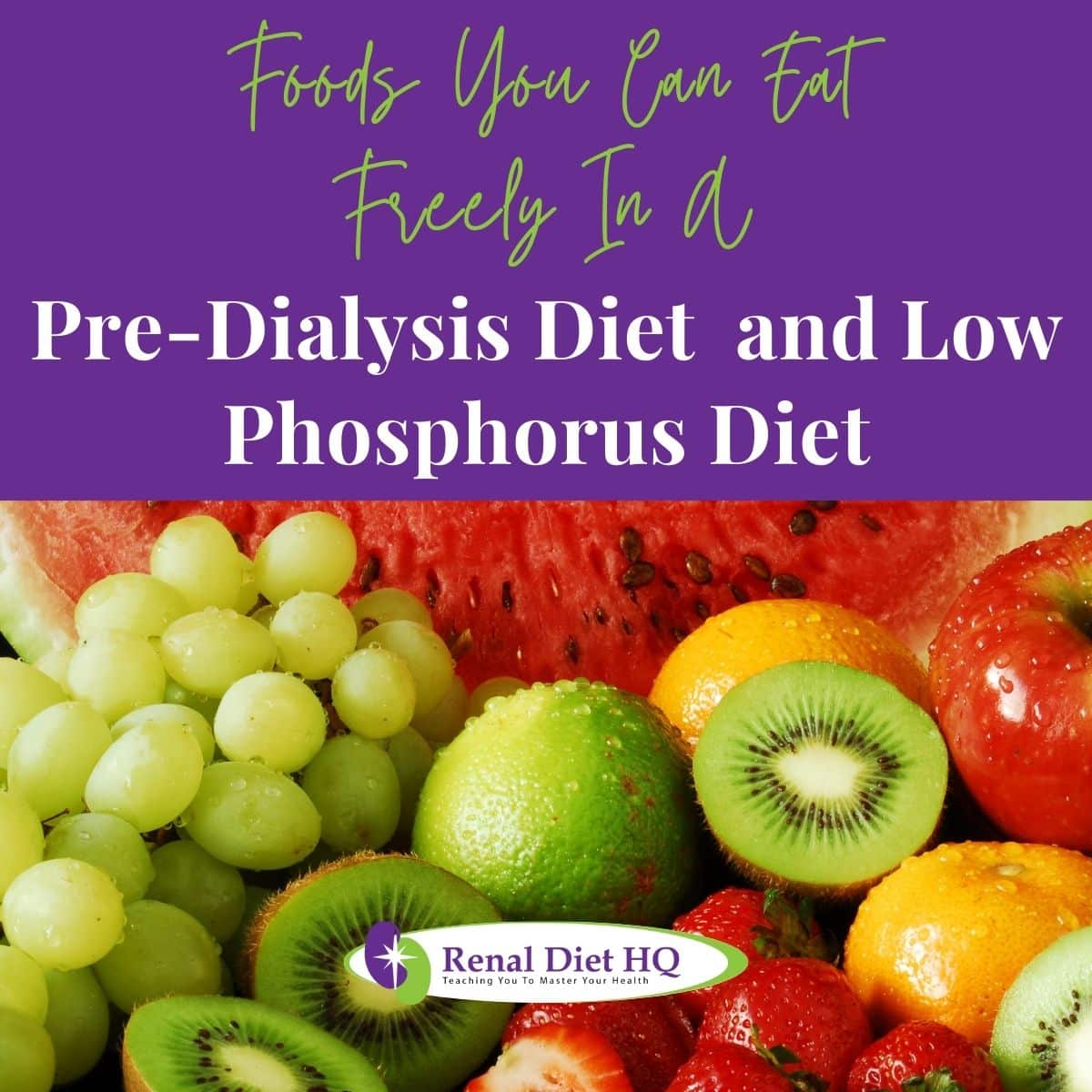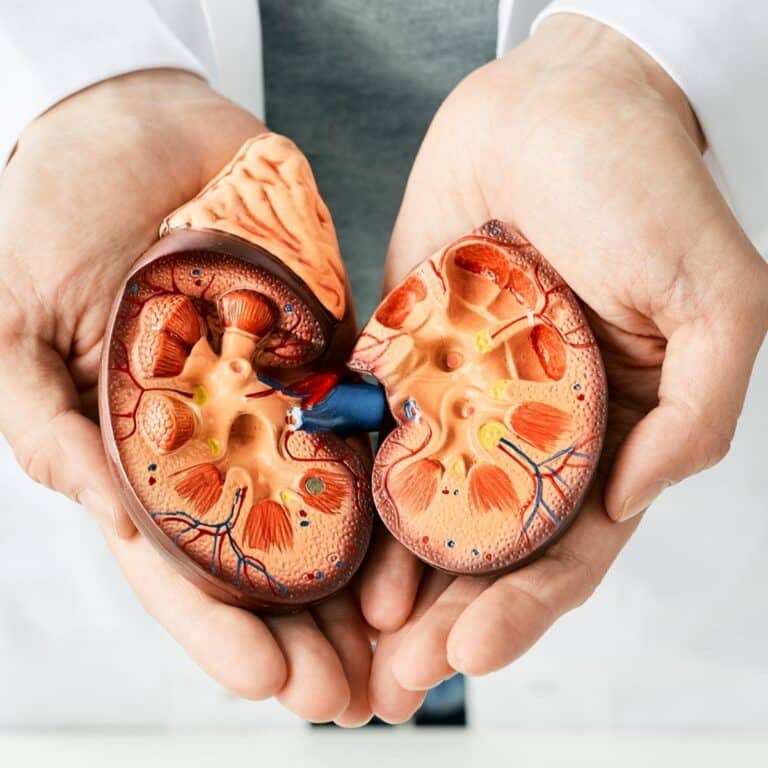Low Phosphorus Foods
Are you or someone you know struggling with chronic kidney disease (CKD)? If so, it's important to pay attention to your diet and limit certain nutrients like phosphorus.
Phosphorus is essential for bone health and energy production, but when kidneys aren't functioning properly, excess phosphorus can build up in the body and lead to further complications in the kidney diet plan.
A low phosphorus diet is crucial for individuals with kidney disease as it helps slow down the deterioration of kidney functions. There are even facts about Chronic Kidney Disease worth checking out.

By limiting protein and phosphorus intake through food choices, waste build-up can be counteracted.
This article will provide practical suggestions for low phosphorus foods that are suitable for a pre-dialysis diet, helping you maintain a healthy lifestyle while slowing down kidney function loss and avoiding dialysis. Yes, there are tips for eating a pre-dialysis diet, you just have to follow them.
Jump to:
- Key Takeaways
- Importance of Phosphorus
- Phosphorus and Kidney Disease
- Dietary Phosphorus Intake
- Food Choices for a Kidney Diet
- Red Meats for a Kidney Diet
- Seafood for a Kidney Diet
- Bread and Grains for a Kidney Diet
- Dairy Products for a Kidney Diet
- Eggs and Cheese for a Kidney Diet
- Resources for a Kidney Diet
- FAQs about A Low Phosphorus Diet
- A Low Phosphorus Diet is A Part of The Pre-Dialysis Diet
Key Takeaways
- A low phosphorus diet is recommended for those with chronic kidney failure to slow down deterioration of kidney functions and avoid dialysis.
- Phosphorus build-up causes calcium to be drawn from bones and deposited in other parts of the body, leading to mineral and bone disorders.
- Fresh fruits, vegetables, non-dairy creamers, un-enriched soy or rice milk, creamer, enriched white bread, and light-colored soft drinks can be eaten freely on a low phosphorus diet, while dairy products, dried beans, peas, seeds, nuts, leafy green vegetables, mushrooms, parsley, colas, dark-colored soft drinks, processed meats, dried fruits, fish, seafood, and whole grain foods should be restricted or avoided.
- A renal dietitian can help manage phosphorus intake based on individual needs, and resources such as kidney-friendly cookbooks are available for download.
For More Recipes and Ideas --->> Get Your Free Meals and Recipes That Are Perfect for Pre-Dialysis Diets, Pre-Dialysis with Diabetes, or Dialysis Diets.
Importance of Phosphorus
You may not realize it, but phosphorus plays a crucial role in your body and can greatly affect the progression of kidney disease. Phosphorus is essential for many bodily functions, including energy metabolism, cell growth and repair, and bone health.
However, when you have kidney disease, your kidneys can't remove extra phosphorus from your blood as effectively as they should. This can lead to an imbalance of minerals in your body and cause damage to your bones and cardiovascular system.
A Low Phosphorus Diet together with a Pre-Dialysis Diet, is a crucial part of treating chronic kidney failure. Research has shown that a low phosphorus renal diet can significantly slow down the deterioration of kidney functions. Your diet will also affect how you feel and if your day to day activities are restricted.
The daily recommended intake of phosphorus for people with kidney disease is between 800 and 1,000 mg. It's important to be aware of the amount of phosphorus in the foods you eat so that you can manage your intake accordingly.
Foods high in phosphorus include dairy products, beans, nuts, whole grains, processed meats, fish, and seafood. By choosing low-phosphorus alternatives such as fresh fruits and vegetables, lean meats without breading or sauce, and liquid dairy substitutes like almond milk or rice milk instead of cow's milk products, you can help slow down the progression of kidney disease.
Excessive amounts of dietary phosphorus can lead to mineral imbalances that negatively impact bone health and contribute to cardiovascular disease risk factors such as high blood pressure.
Some processed foods contain added phosphate additives that increase their shelf life or improve texture, but also add unnecessary amounts of phosphorus, which makes them harmful for people with kidney diseases.
To manage your phosphorus intake more effectively, supplements are available such as phosphate binders, which help reduce the absorption rate of dietary phosphate into the bloodstream, thereby reducing its harmful effects on kidneys. This ensures optimal levels are maintained elsewhere in your body without compromising other vital functions required by it.
Your kidney doctor will determine your need for taking phosphate binders and the dose you need. Hence, be sure to consult your doctor and have your regular blood tests done to ensure that you get the optimal management.
Phosphorus and Kidney Disease
Adopting a low phosphorus diet can bring significant benefits for you as a patient with chronic kidney disease. Diseased kidneys struggle to efficiently process and eliminate phosphorus from the body, leading to high levels in the blood. By following a low phosphorus diet and eating low phosphorus meats, you can help manage your condition and improve your overall health.
Limiting phosphorus intake is crucial because high phosphorus levels can contribute to various complications associated with CKD. Elevated phosphorus levels can disrupt the balance of minerals in your body, leading to bone and mineral disorders.
Excess phosphorus can bind with calcium, resulting in weakened bones, bone pain, and an increased risk of fractures. By reducing phosphorus intake, you can minimize these risks and support bone health.
Moreover, a low phosphorus diet plays a crucial role in managing cardiovascular health. High phosphorus levels in the blood can lead to calcification, which is the buildup of calcium in blood vessels and heart tissues.
This calcification can contribute to the development of cardiovascular diseases such as heart disease and stroke. By limiting phosphorus intake, you can help prevent these complications and protect your cardiovascular system.
Following a low phosphorus diet also helps in managing the progression of CKD itself. High phosphorus levels can contribute to the progression of kidney damage and decrease kidney function.
By reducing phosphorus intake, you can ease the burden on your kidneys, slowing down the progression of CKD and preserving kidney function for a longer period.
Remember, eating low phosphorus foods should be done in consultation with a registered dietitian who can provide personalized guidance based on your specific needs.
By incorporating a low phosphorus diet into your lifestyle, you can help manage your CKD, protect your bones and cardiovascular health, and slow the progression of kidney damage.

Dietary Phosphorus Intake
Managing your kidney health requires being mindful of the amount of phosphorus in your diet and making informed food choices to ensure proper mineral balance. Phosphorus is an essential nutrient that plays a critical role in bone health, cell function, and energy production.
However, too much phosphorus in the blood can lead to complications like mineral and bone disorders, cardiovascular disease, and even death.
Foods to Restrict When Following a Pre-Dialysis Diet and Low Phosphorus Diet:
- Dairy products such as milk, cheese, yogurt and ice cream. You should restrict milk to half a cup a day. Avoid using milk in sauces. Which cheese is good for ckd patients?
- Dried beans, peas and seeds
- Nuts including peanut butter
- Leafy green vegetables, mushrooms and parsley
- Colas and dark colored soft drinks
- Processed meats
- Dried fruits
- Fish and seafood can have high potassium levels
- Whole grain foods
- Chocolate
Phosphorus sources include dairy products, meat, poultry, fish, eggs, nuts, seeds, legumes, beans, whole grains, cereals, bread, pasta, rice, oats, quinoa, bulgur, barley, millet, cornmeal, rye flour, wheat flour, bran, flaxseed meal, chia seeds, sesame seeds, poppy seeds, sunflower seeds, pumpkin seeds. wheat germ, amaranth, farro, spelt, and kamut.
Phosphorus absorption depends on various factors such as age (older adults absorb more), vitamin D status (vitamin D enhances absorption), calcium intake (calcium binds with phosphorus limiting its absorption), type of food preparation (cooking reduces availability), medications or supplements (some cause changes in absorption).
Phosphorus metabolism involves complex mechanisms that regulate its levels in the blood. Phosphorus toxicity occurs when there is an imbalance between dietary intake and excretion by kidneys leading to hyperphosphatemia (high phosphate levels) which has adverse effects on bones and blood vessels. This is a complication usually observed in end stage renal disease patients.
To control phosphorus intake from foods, drinks, and supplements, it's crucial to read labels carefully for phosphorus additives like 'phosphate', 'phos', 'phosphoric acid', 'monosodium phosphate', 'disodium phosphate', 'trisodium phosphate', 'polyphosphate', 'pyrophosphate' or 'sodium tripolyphosphate'.
Also, avoid processed foods, packaged foods, convenience foods, fast food , junk food, fried salty foods, processed flavored beverages, snacks, and desserts that are high in phosphorus content.

Foods You Can Eat Freely in a Pre-Dialysis Diet and Low Phosphorus Diet
- Fresh fruits except bananas and oranges
- Vegetables such as green beans, onions, garlic bell peppers. Restrict leafy vegetables and potatoes (leaching potatoes).
- Non-dairy creamers, un-enriched soy or rice milk
- Creamer
- Enriched white bread
- Light colored soft drinks
Choose fresh or frozen fruits, vegetables, herbs, spices, non-dairy milk substitutes, bread, cereal, pasta, rice, oats, quinoa, barley, millet, popcorn, lean meats, poultry, fish, seafood, tofu, eggs; low-fat cheese, yogurt, sour cream, butter, and margarine; and limit nuts, seeds, legumes, and beans.
Phosphorus supplements should be taken only under medical supervision as excess intake can harm the body. A dietitian can help create a personalized meal plan that meets your specific needs and preferences while ensuring optimal kidney health.
Food Choices for a Kidney Diet
Making informed food choices is essential for maintaining kidney health. When planning meals for a kidney diet, it's important to choose lean meats without breading or marinades. Seafood is also an excellent source of low-fat, high-quality protein that can be included in a kidney-friendly meal plan.
When grocery shopping, read labels carefully and choose foods with lower phosphorus content.
Whole grain breads have more phosphorus and potassium than white flour bread, while whole grains like brown rice and oat bran are limited due to their higher phosphorus content.
Milk and milk products are high in calcium and phosphorus, so liquid dairy substitutes can be used in cooking to replace milk.
A registered dietitian can help create a personalized meal plan that takes into account individual dietary needs while providing nutrient balance, especially when it comes to having to limit your phosphorus consumption. Kidney-friendly recipes are also available online for inspiration when planning meals.
Red Meats for a Kidney Diet
If you have kidney disease, it's important to choose fresh or frozen red meats without breading or marinades to ensure you're getting a good source of protein in your diet. Red meats such as beef, pork, and lamb provide high-quality protein with all the essential amino acids your body needs.
However, preparation methods can affect the nutritional value of the meat. To make sure you're maximizing the nutritional value of your red meat while keeping phosphorus levels low, consider these cooking tips:
- Grill or broil instead of frying to avoid adding extra fat and calories.
- Trim visible fat before cooking to reduce saturated fat intake.
- Use portion control by limiting red meat consumption to small amounts (3-4 ounces) per serving.
- Consider alternative protein sources such as poultry, fish, eggs, tofu, and legumes for variety in your diet.
Remember that a balanced kidney-friendly diet is important for managing kidney disease. Consult with a registered dietitian who specializes in renal nutrition for personalized recommendations on food choices and portion sizes that fit within your individualized dietary restrictions.
Seafood for a Kidney Diet
Seafood is an excellent source of low-fat, high-quality protein and can be a great addition to your kidney-friendly meal plan. It also contains omega-3 fatty acids which are beneficial for heart health.
When choosing seafood for your kidney diet, opt for fresh or frozen options without breading, marinades or sauce. What fish is good for kidneys? Low potassium fish such as salmon, cod, haddock, pollack, trout, and flounder are all great sources of protein with low amounts of phosphorus. These options are also high in protein and healthy fats.
Incorporating seafood into your meals can be easy and delicious. Try recipes like grilled salmon with lemon-dill sauce or trout filet stir-fry with vegetables. You can even try things like fresh or canned vegetables for a renal diet with your seafood.
If you're not a fan of seafood or need to limit your intake due to other health concerns, there are substitutes available such as tofu or seitan which can provide similar nutritional benefits. By incorporating seafood into your kidney-friendly meal plan, you can enjoy its many health benefits while still managing your phosphorus intake effectively.
Bread and Grains for a Kidney Diet
When it comes to following a kidney-friendly diet, you'll be happy to know that there are plenty of delicious bread and grain options available for you to enjoy. However, it's essential to consider your phosphorus limits when selecting these foods.
Whole grain bread may have more phosphorus than white flour bread, so portion control is crucial. Gluten-free options can also be a great choice for people with kidney disease who may have other dietary restrictions.
Alternative grains like quinoa, buckwheat, or millet can provide variety in your diet while being low in phosphorus. Additionally, incorporating fiber sources like brown rice or oat bran can help maintain healthy digestion in amounts that would not exceed your phosphorous limit.
Remember that a renal dietitian can help create a personalized meal plan based on your individual needs. They can guide you on portion control and suggest alternatives if needed. You can also use these tips for following a low sodium kidney diet.
Dairy Products for a Kidney Diet
To follow a kidney-friendly diet, you should be mindful of your dairy product intake and consult with a renal dietitian to determine appropriate portion sizes and alternatives. Dairy products are high in calcium and phosphorus, which can be problematic for individuals with chronic kidney disease.
Here are some tips on how to make dairy work for you:
- Consider alternatives to dairy such as non-dairy creamers, un-enriched soy or rice milk, and creamer.
- Look for low phosphorus cheeses like brie, camembert, feta cheese, goat cheese, ricotta cheese, vegan cheese, and cream cheese. Check these cheese substitutes for renal diet.
- Experiment with milk substitutes like almond or coconut milk that have lower levels of phosphorus.
- Incorporate other sources of calcium into your diet through foods like kale, collard greens, broccoli, and tofu. For greens make sure that you do not exceed your daily potassium limit.
Kidney-friendly desserts can also be made using substitutes for regular milk. For example, try making pudding with almond milk or fruit smoothies with coconut milk instead of cow's milk.
Remember that moderation is key when it comes to managing your phosphorus intake. By working closely with a renal dietitian and being mindful of your food choices, you can enjoy a healthy and satisfying diet even with chronic kidney disease.
Eggs and Cheese for a Kidney Diet
If you're looking for protein sources in your kidney-friendly diet, incorporating eggs and cheese in moderation can be a delicious addition to your meals. Eggs are an excellent source of high-quality protein, with one large egg containing about 6 grams of protein.
They are also low in phosphorus, making them a great choice for those on a low phosphorus diet. Additionally, they contain important nutrients like vitamin D and choline which are beneficial for kidney health.
Cheese is another popular dairy product that can be included in a kidney-friendly diet. While it is higher in phosphorus than other dairy products, there are low phosphorus alternatives available such as cream cheese or brie.
Cheese is also high in calcium which can help maintain strong bones and teeth. It's important to limit intake to one ounce per serving if phosphorus levels need to be controlled.
Incorporating eggs and cheese into a kidney-friendly meal plan can be easy and delicious. Try scrambled eggs with non-dairy creamer instead of milk or using egg whites instead of whole eggs to lower cholesterol intake.
For cheese lovers, try adding small amounts of low-phosphorus options like cream cheese or feta to salads or sandwiches. Remember to consult with a renal dietitian to determine the appropriate portions for your individual needs. It's vital to know everything about eggs and kidneys!
Resources for a Kidney Diet
Now that you've learned about the importance of managing your phosphorus intake and the recommended portion sizes for eggs and cheese in a kidney diet, let's explore some resources that can help you plan your meals.
Kidney diet meal plans are available online, written by registered dietitians who specialize in renal nutrition. These meal plans provide a week's worth of recipes and grocery lists tailored to fit your individual dietary needs. They take into account your protein, sodium, potassium, and phosphorus restrictions while still providing tasty and satisfying meals.
If you need more personalized guidance on managing your kidney disease through diet, consider scheduling a consultation with a renal dietitian. They can assess your current nutritional status and create a customized meal plan that fits within your lifestyle and preferences.
In addition to kidney-friendly meal plans and renal dietitian consultations, there are many other resources available to help you stay on track with your kidney diet.
With these resources at hand, you'll be well-equipped to manage your phosphorus intake while still enjoying tasty meals that support optimal health. Don't forget that learning how to grocery shopping with CKD also gets easier with time.
FAQs about A Low Phosphorus Diet
If you're looking for fast food options that are kidney-friendly, it's important to pay attention to the nutritional content of your meal. Many fast food items are high in phosphorus and sodium, which can be detrimental for individuals with kidney disease.
However, some restaurants offer low phosphorus diet options. For example, grilled chicken sandwiches without cheese or sauce, salads with low potassium toppings like cucumbers and carrots, and baked potatoes without the skin.
It's also important to remember that accessibility may vary depending on the restaurant's location and availability of certain menu items. To ensure a healthy meal choice, consider researching nutritional information online before making a decision.
Phosphorus binders work by binding to excess phosphorus in the gut and preventing its absorption into the bloodstream. These medications can effectively reduce phosphorus levels in those with kidney disease, but they do have side effects such as constipation and upset stomach.
Natural remedies for reducing phosphorus levels include increasing the intake of fruits and vegetables, reducing the intake of high-phosphorus foods like dairy products and processed meats, and drinking plenty of water. There are tons of kidney friendly drinks to try!
High levels of phosphorus can negatively impact bone health, so it is important to consider the role of vitamin D in phosphorus absorption. For those on renal diets for managing phosphorus levels, it's best to work with a registered dietitian to develop a personalized plan that takes into account individual needs and preferences.
If you're on a low-phosphorus diet, there are plenty of alternative sources of calcium and protein to choose from.
Plant-based protein options like tofu, tempeh, and legumes can be great choices. Dairy alternatives like almond milk or coconut yogurt can also provide calcium without the extra phosphorus.
Low-phosphorus vegetables such as broccoli, kale, and green beans are also good choices for getting enough nutrients while sticking to your diet restrictions. When it comes to seasoning your meals, opt for low-sodium options instead of salt.
Finally, consider incorporating low-phosphorus grains like quinoa or barley into your meals for added nutritional benefits. Remember to consult with a renal dietitian for personalized recommendations that fit within your specific dietary needs and restrictions.
Not everybody who suffers from kidney failure will be treated with dialysis. It is only when the kidney function falls to about 10% of normal that dialysis is initiated. Dialysis is expensive and inconvenient, involving major changes to your daily routine.
What you eat can help or hinder your kidney function significantly. That is why doctors recommend the Pre-dialysis Diet together with a Low Phosphorus Diet as a way to slow down the loss of function of kidneys.
With proper guidance from healthcare professionals, a low phosphorus diet can be an effective tool in managing chronic kidney disease.
Phosphorus is an essential mineral in the body, but in renal patients, high phosphorus levels can negatively impact cardiovascular health.
Elevated phosphorus levels can interact with calcium, resulting in the formation of harmful deposits in blood vessels, lungs, eyes, and the heart. This process, occurring over time, significantly raises the risk of heart attack, stroke, and even mortality.
Therefore, monitoring and controlling phosphorus levels are essential in managing cardiovascular health in individuals with kidney disease. By effectively managing phosphorus levels, healthcare providers can help mitigate the potential risks and promote better cardiovascular outcomes in these patients.
A Low Phosphorus Diet is A Part of The Pre-Dialysis Diet
Why do you need a pre-dialysis diet plan? Both the Pre-dialysis Diet and the Low Phosphorus Diet are aimed at boosting the effectiveness of your medical renal treatment by regulating the amount of waste products in your blood.
Your diet must provide all the nutrients your body needs while placing as little stress as possible on the kidneys, thus enabling them to retain their function for as long as possible before needing assistance from dialysis.
There are also many resources available to help you maintain a healthy lifestyle while managing your kidney disease. These include online resources, support groups, and educational programs offered by health care providers.
Your kidney function is, to a large extent, in your own hands. Your diet will make a big difference as to how you feel and how you function. You will be able to live a normal life for far longer if you care for your kidneys.
Stick to your Pre-Dialysis Diet faithfully and also eat a Low Phosphorus Diet to give your kidneys the best chance of coping without the need for dialysis.














